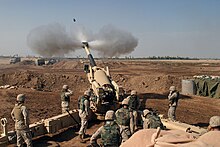Muzzle brake

The muzzle brake is a device on the barrel ( muzzle of firearms ) that uses the energy of the combustion gases to reduce the recoil of the weapon. Muzzle brakes are mainly used on automatic cannons and artillery pieces , less often on handguns .
The compensator , the flash hider and the recoil amplifier must be distinguished from the muzzle brake . By directing the muzzle gases upwards, compensators reduce the throwing-up of handguns. Muzzle flash suppressors reduce the visible muzzle flash and thus also the glare effect of the muzzle flash for the shooter himself and his visibility when firing a shot. In contrast to the muzzle brake, a recoil amplifier increases the recoil energy when firing in order to ensure the reloading function of automatic weapons during the burst and to increase the firing frequency (e.g. with the MG3 ).
function
There are basically three types of muzzle brakes: active , reactive and active-reactive .
The active muzzle brake consists of one or more baffles mounted in front of the barrel muzzle with openings on the sides, which are firmly connected to the barrel. These baffles have an opening for the bullet to pass through , the diameter of which is approximately 1.1 times the bullet caliber. Immediately after the projectile has left the barrel, the high pressure combustion gases of the propellant escape from the barrel and partially hit the impact surfaces of the muzzle brake. Since a large part of the gas pressure escapes to the sides instead of the front, the rocket effect and thus the recoil is significantly reduced. However, this increases the sound pressure exposure for the shooter himself and to a greater extent for people to the left and right of the muzzle brake. In order to increase the efficiency of the active muzzle brake and to reduce the loss from the opening of the first impact surface, a second impact surface is often used in guns.
The reactive muzzle brake has several radial bores, which deflect the gases to the side or even slightly backwards and reduce the recoil due to the resulting opposing force. The efficiency of a reactive muzzle brake, but also the sound pressure load on the operator behind the weapon, increases with the angle at which the gases are deflected. In order not only to reduce the recoil, but also to counteract the problem of kicking up, some muzzle brakes for handguns also have openings on the top and thus more or less pronounced compensator properties.
The active-reactive muzzle brake finally combines both principles by first using the gas pressure on the impact surfaces and then diverting the gases backwards.
In order to counteract the unpleasant effect of the increased sound pressure exposure for those standing by, additional devices are often offered for modern muzzle brakes for handguns. These funnel-shaped devices deflect the gases to the front, which emerge from the side of the muzzle brake. This significantly reduces noise pollution, but the kickback-reducing effect is lost. These facilities are intended for training on shooting ranges.
Muzzle brake of a 7.5 cm PaK 40
Muzzle brake of a 30 mm Mauser automatic cannon
The French sniper rifle PGM Hécate II with a striking muzzle brake
According to the manufacturer, the Barrett M82's muzzle brake absorbs up to 70% of the recoil
See also
literature
- Stanisław Torecki: 1000 terms on weapons and balistics . 3rd revised edition. Publishing house of the Polish Ministry of Defense, Warsaw 1982, ISBN 83-11-06699-X (289 pages, Polish: 1000 słów o broni i balistyce . First edition: 1973).
Web links
Individual evidence
- ↑ a b wiki.waffen-online.de: wiki.waffen-online.de - weapons muzzle attachment. In: wiki.waffen-online.de. November 8, 2019, accessed January 26, 2020 .
- ^ Bryan: Muzzle Devices 101. In: sportsmansguide.come. October 31, 2018, accessed January 27, 2020 .
- ↑ wiki.waffen-online.de: wiki.waffen-online.de - weapons muzzle centering device. In: wiki.waffen-online.de. January 24, 2020, accessed January 26, 2020 .






